Introduction
Welcome to our Full Draft Guide for MTG’s latest limited set: The Brothers’ War (BRO). Not for the faint of heart, this guide dives deep into the set, exploring the strategies and synergies that will help you rise to the top during your next draft. From Mechanics to Archetypes, from Drafting Mono Color to The Top Commons we’ve attempted to cover as much ground as possible including a special section on the cards available in the Retro Artifacts. Ready? Let’s get into it!
Contents
1. Mechanics - Prototype - Powerstones - Unearth - Meld 2. Retro Artifacts 3. Fixing, Splashing and Playing Three Colors 4. Drafting Mono Color Decks 5. Two Color Archetypes - Azorius (White-Blue) - Selesnya (White-Green) - Dimir (Blue-Black) - Rakdos (Black-Red) - Gruul (Red-Green) - Orzhov (White-Black) - Golgari (Black-Green) - Izzet (Blue-Red) - Boros (White-Red) - Simic (Blue-Green) 6. Top Commons - White - Blue - Black - Red - Green - ColorlessMechanics
Prototype
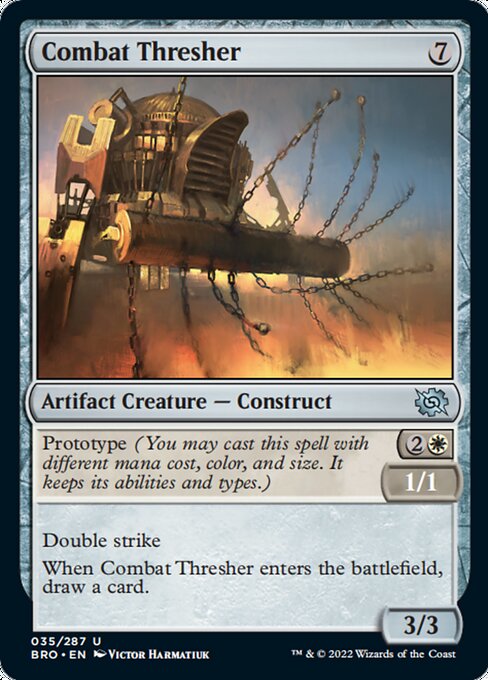

Prototype is a brand new mechanic for The Brothers’ War. This keyword appears on colorless artifact creatures, introducing an alternative casting cost - with colored mana. When creatures are cast using the Prototype cost they are cast with a different mana cost, color, and size, but the creature’s abilities and types remain unchanged.
This mechanic is great for limited as it introduces an element of flexibility as well as shaking up typical deck building restrictions. Now players can include several high mana cost cards in their decks without the usual risk of having those cards rotting, uncastable in their hand.
Powerstones
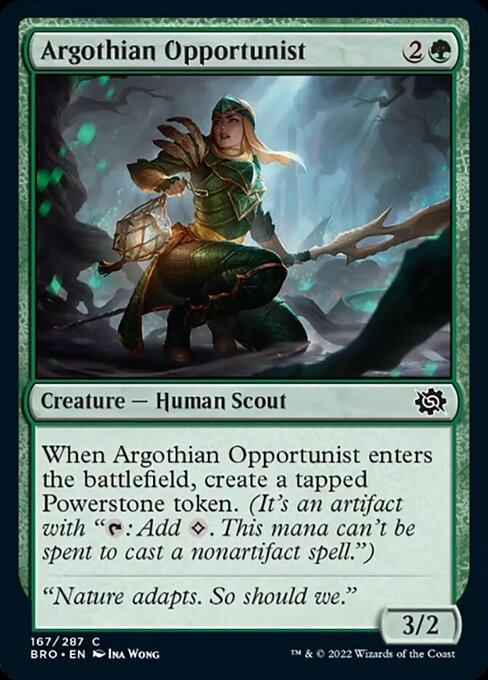
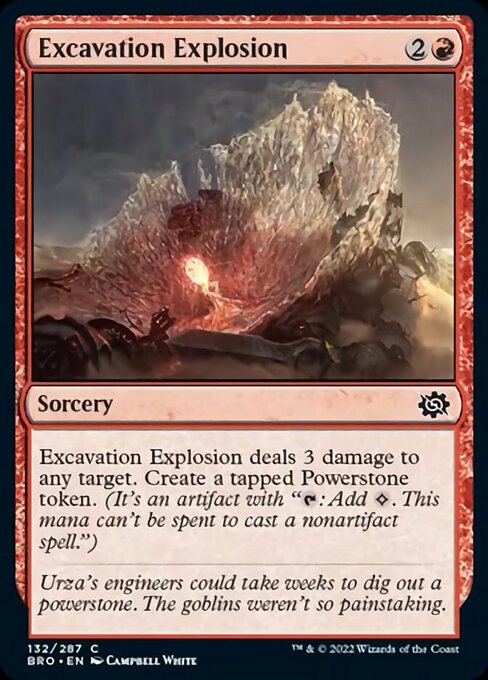
Powerstones are the headline mechanic for The Brothers’ War. These tokens are artifacts which can be tapped to add colorless mana. This mana can’t be used to cast non-artifact spells and Powerstones enter the battlefield tapped. It’s worth noting that, although the mana can’t be used to cast non-artifact spells, it can be used to pay for activated abilities regardless of the color of that card.
Naturally great for ramping into expensive artifacts, Powerstones, being central to the design of the set, have a variety of uses in The Brothers’ War. This ranges from paying for activated abilities such as Unearth costs to acting as sacrifice fodder in Red and Black.
Unearth
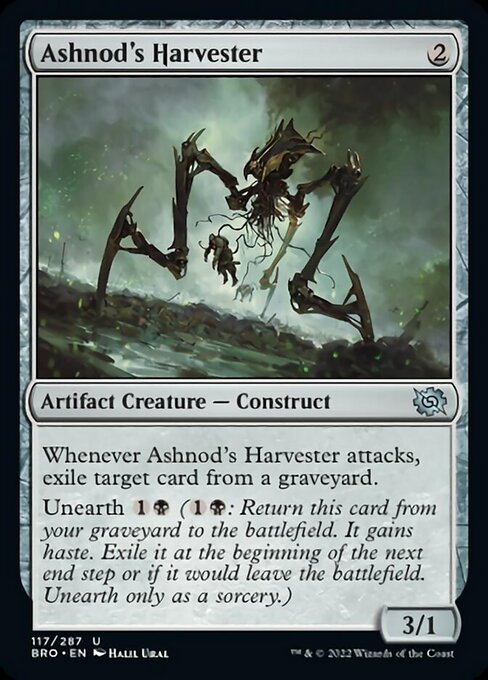
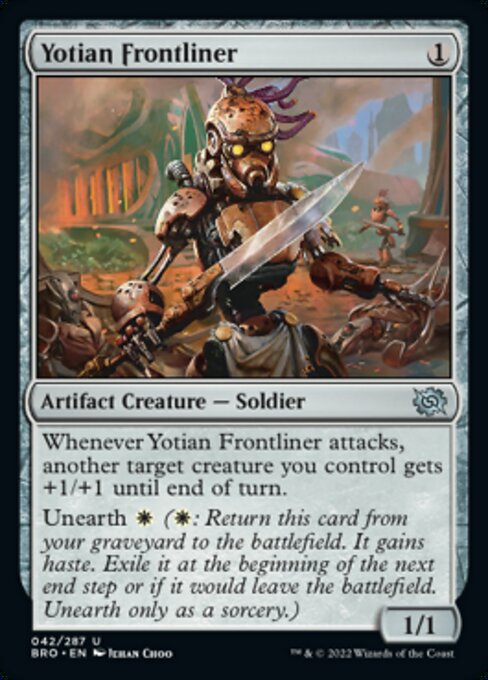
Unearth is a returning mechanic seen on artifacts and creatures. This activated ability allows you to return those cards from the graveyard to the battlefield by paying the associated mana cost. Any permanents returned in this manner gain haste and will be exiled at the beginning of the next end step.
This mechanic is also great for limited, as it provides a mana sink giving players more options late in the game. It also synergises nicely with the set’s headline mechanic, as you can use mana generated by Powerstones to pay for this activated ability. Furthermore, there are several ways in The Brothers’ War to get artifacts (and cards in general) directly from your library to your graveyard, such as self-mill. This means that Unearth can provide a host of value for those who take advantage of these micro synergies.
The Brothers' War
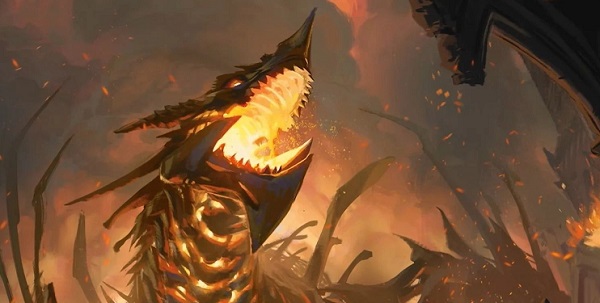
Meld
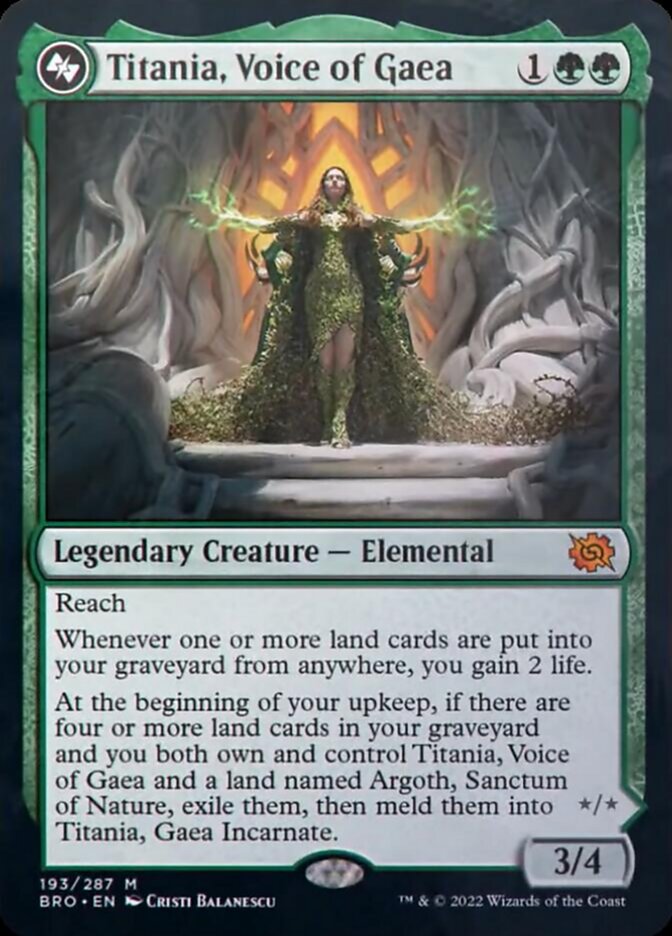
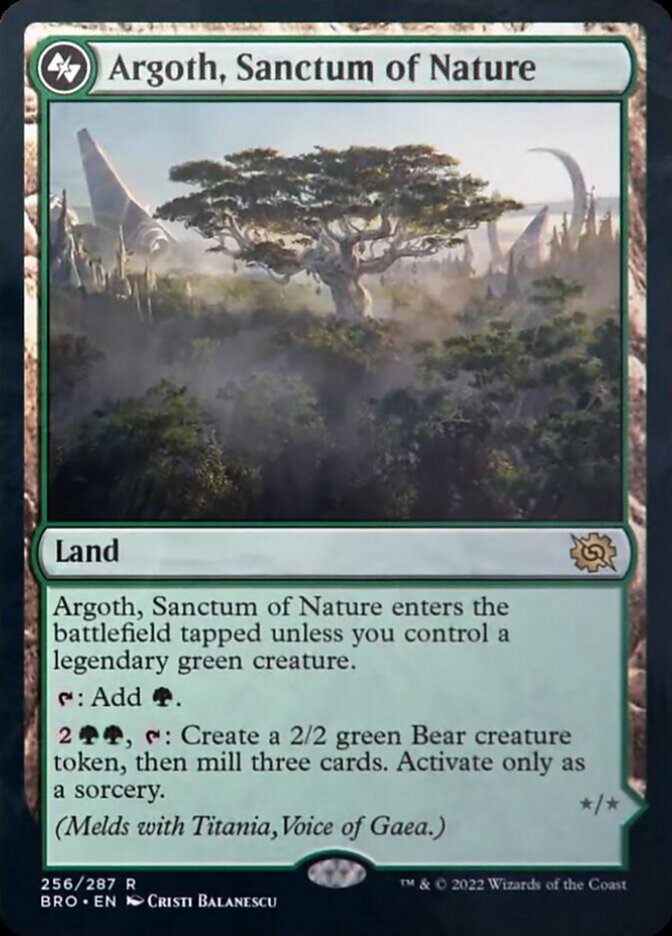
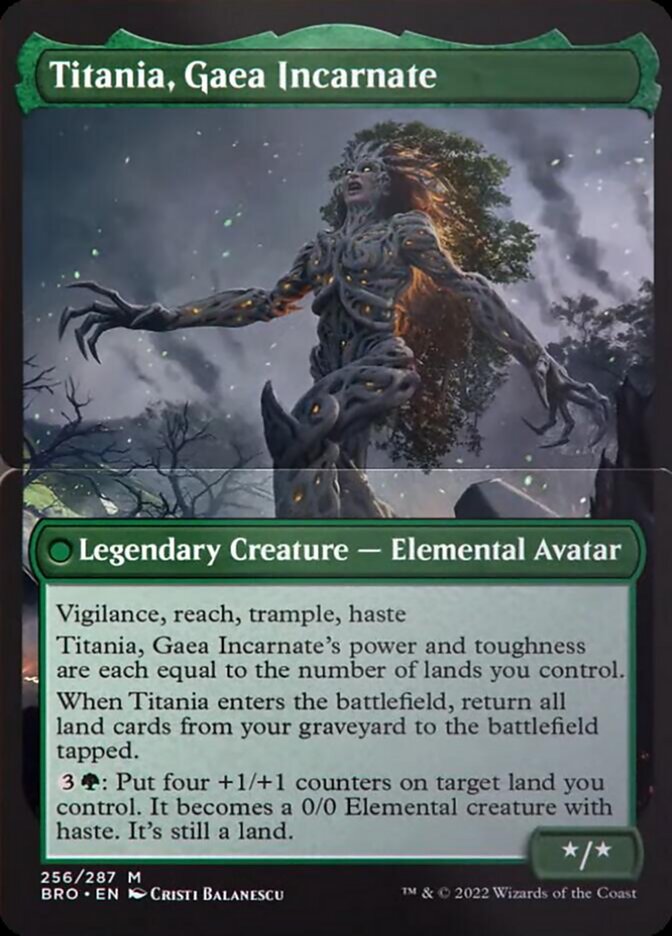
Meld is a mechanic which is unlikely to impact games of limited more than once in a blue moon. Appearing on only six cards in The Brothers’ War, this mechanic requires you to have a specific pair of cards on the battlefield before it can potentially activate. When the conditions are met, both cards are flipped over and melded together to create a double sized super card of enormous power. Although visually exciting, with each pair of cards consisting of a rare and a mythic, the chances of pulling this off in a game of limited are slim to none.
Retro Artifacts
Each draft booster from The Brothers’ War will also contain a card from The Brothers’ War Retro Artifacts. Similar to the Mystical Archive in Strixhaven, each pack has a dedicated slot for an artifact card from Magic’s history. This introduces an element of variance which has the potential to lead your draft down an unexpected route.

Of course there are stonecold limited bombs in the Retro Artifacts such as Wurmcoil Engine, however the likelihood of finding one of these in your pack is low and, assuming your neighbours have played Magic before, the chance of getting passed one should be zero.
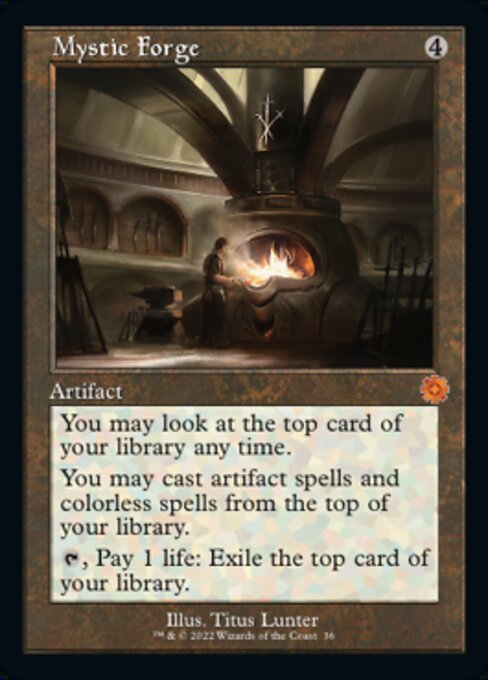

There are also powerful build-arounds such as Mystic Forge which strongly incentivise building an artifact only deck, as well as Quicksilver Amulet, which could encourage you to pack your deck with high mana cost Prototype cards.
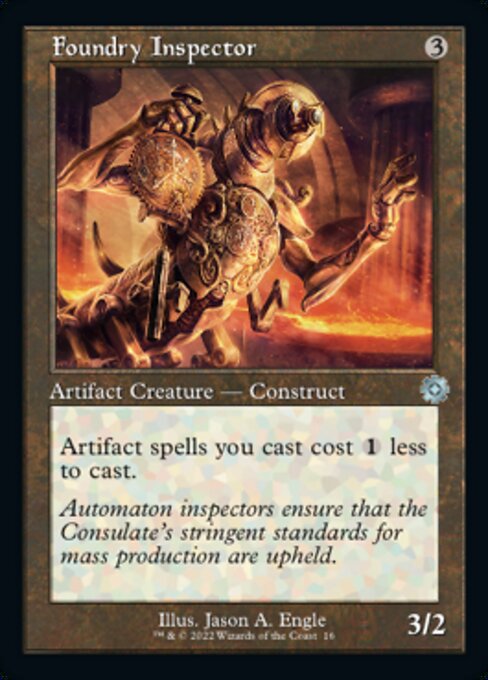
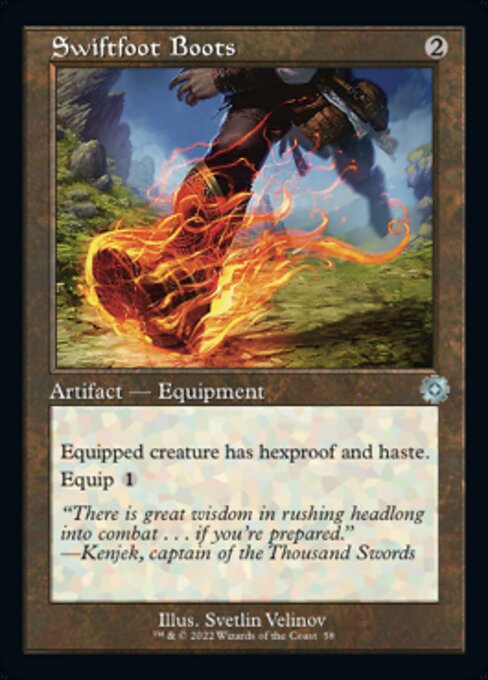
Most limited play however, revolves around the lower rarity cards. Looking towards the uncommons we see Foundry Inspector, a reasonable body for three mana which reduces the cost of any subsequent artifact spells you cast. Also Swiftfoot Boots, an equipment which grants hex-proof and haste. Needless to say hex-proof is a busted ability in limited, especially when combined with a must kill threat.
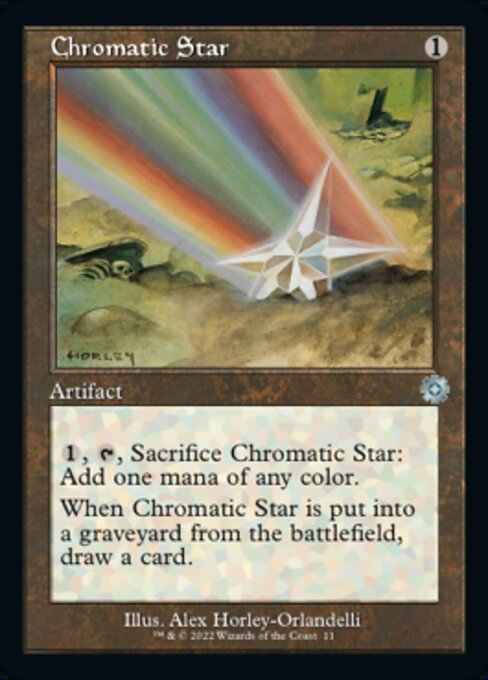

With The Brothers’ War main set being a little thin on fixing, it’s also worth noting that the Retro Artifacts set contains many options which could allow a player to splash or even play three colors. Available at uncommon, Chromatic Star is a viable option, providing a single burst of mana before replacing itself, as is Burnished Hart, an early creature which can be cashed in for up to two basic lands. It’s also worth noting that the sacrifice triggers inherent in these cards may hold additional value, given the artifact sacrifice themes in Red and Black.
Fixing, Splashing and Playing Three Colors
With fixing relatively thin on the ground in The Brothers’ War main set, it’s worth noting that splashing may be difficult and playing three colors almost impossible outside of Green decks. Unless of course you are lucky enough to find fixing in the Retro Artifacts set.
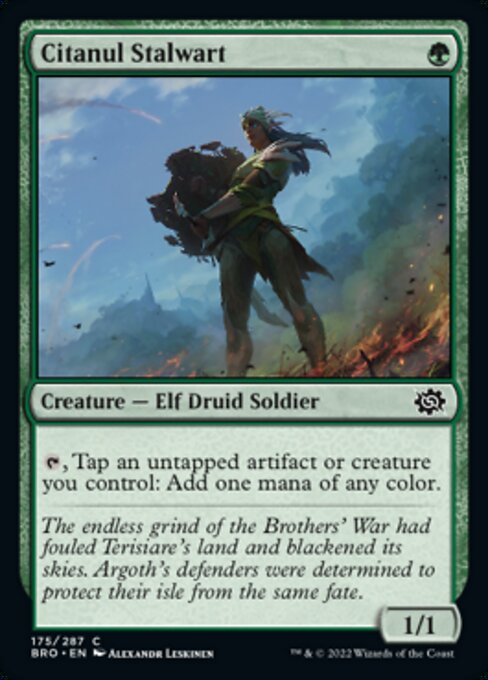
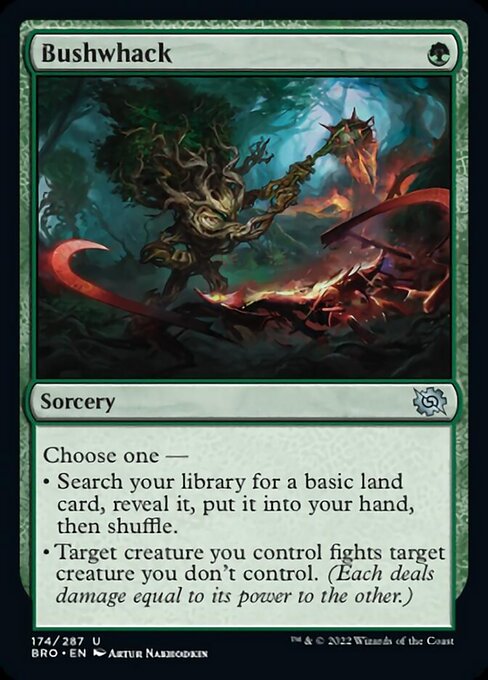
Green does have Citanul Stalwart at common, however it’s a weak card and not one I’m excited to put in my deck. The clause of having to tap an artifact or creature makes this inefficient and the body is vulnerable to say the least. More powerful is Bushwhack which not only provides fixing but can also be used as a fight spell - if that’s more appropriate.
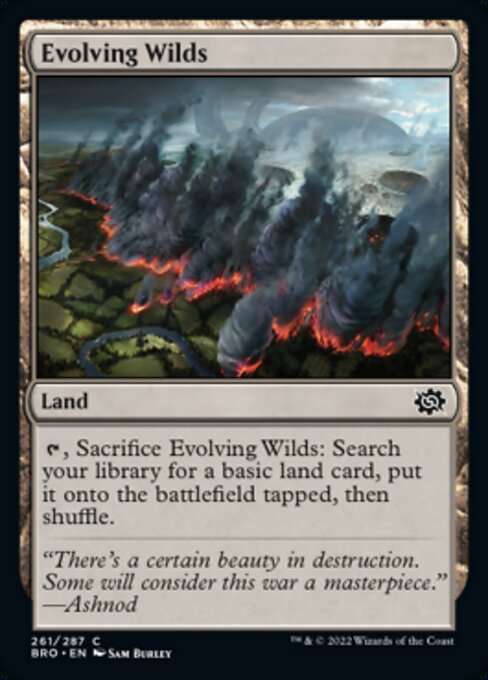
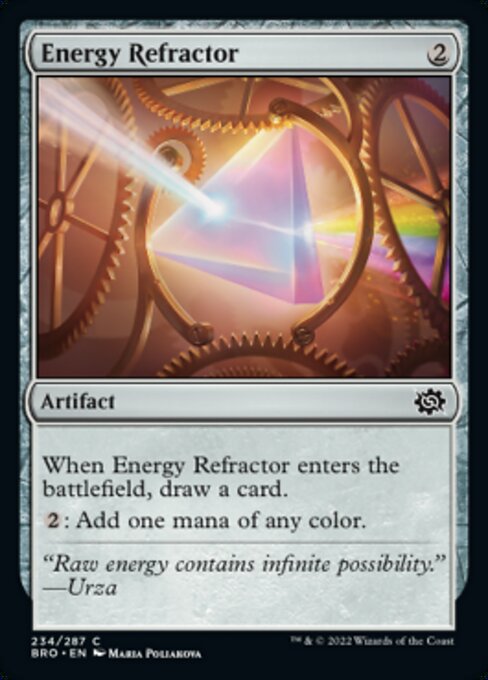
The best bet for enabling a splash at common is Evolving Wilds, although personally I’d rather use this card to shore up a shaky two color mana base rather than stretching to three without any further support. Additionally Energy Refractor is nice because it replaces itself, however the mana tax it creates is real and may well upset your curve.
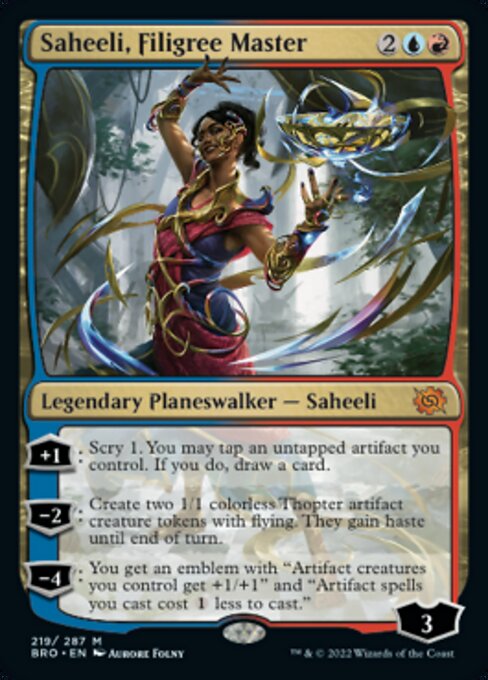
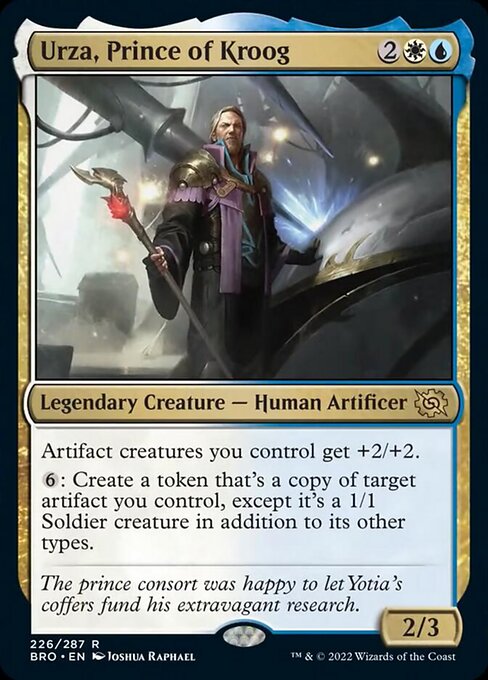
Overall I’d only really recommend splashing for super powerful (and single pipped bombs). Given how splashing will affect your mana base, it often won’t be worth the risk, unless the splashed card is extremely impactful. Planeswalkers such as Saheeli, Filigree Master and creatures such as Urza, Prince of Kroog would certainly make the cut however. I also wouldn't recommend drafting a full three color deck in this set, unless of course you open multiple fixers in the Retro Artifacts set and have strong enough cards in three colors to merit doing so.
The Brothers' War

Drafting Mono Color Decks
When thinking about fixing and manabases, the most glaring exception from The Brothers’ War is the lack of dual lands at common. Without these to smooth our mana, two color decks will be less consistent than usual and those looking to splash will have to stretch their mana further than is often advised.
This consideration, combined with the high number of colorless cards in the set, may push players towards drafting mono color decks. Unrestricted by two-color mana requirements, mono decks can often include less lands - sometimes dropping to 16 or even 15, which increases the efficiency of the deck and ensures that they rarely flood. As if this wasn’t motivation enough, several powerful uncommons have been seeded in the set which may encourage players to take this route.
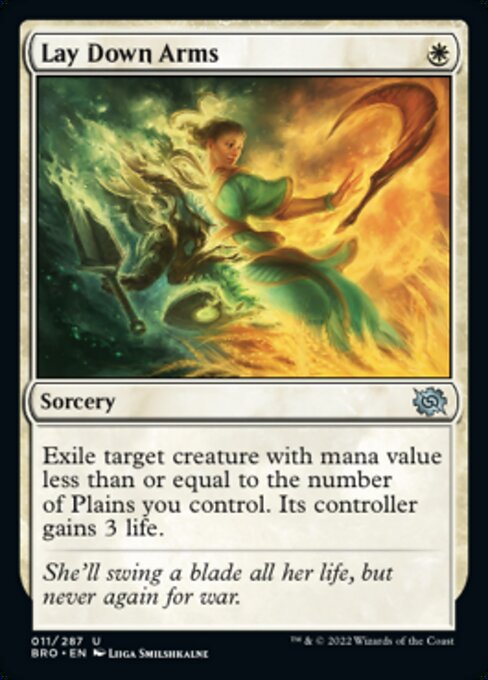
Not quite Swords to Plowshares, Lay Down Arms will however be an incredibly efficient removal spell in the right deck. Of course giving your opponent a life bump is a downside, especially if you are playing a White aggressive deck, however the ability to exile almost any creature is just too good to pass up for just one mana.

It remains to be seen if Flow of Knowledge will be powerful enough to offset the disadvantages of playing Mono Blue, although it’s clear this card can have a lot of upside in the right deck. With its typically weak creatures, Blue usually relies quite heavily on other colors for support - without which it may struggle.

Six mana drain six is a little overpriced, however that's just the floor for Corrupt in a mono black deck. The fact that this can hit your opponent’s face makes it extremely versatile, elevating it from removal spell to a potential finisher that your opponent won’t see coming.
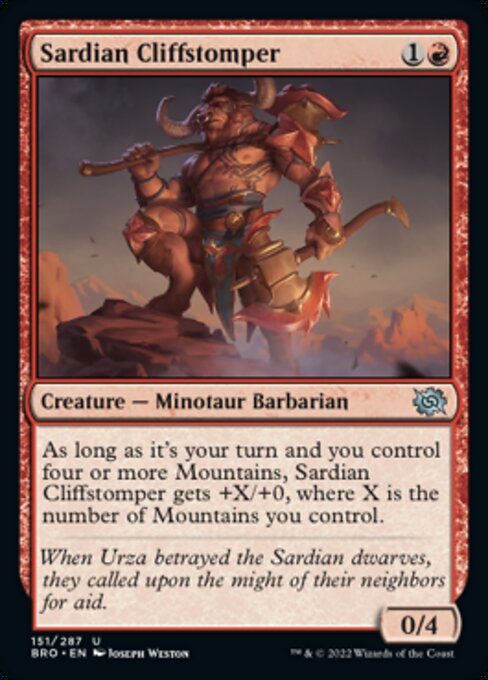
Red’s offering, Sardian Cliffstomper, is an unusual two drop in that it’s essentially a wall until turn four at the earliest. As such I won't be running it out with great enthusiasm on turn two, however later in the game it does become an extremely efficient threat.
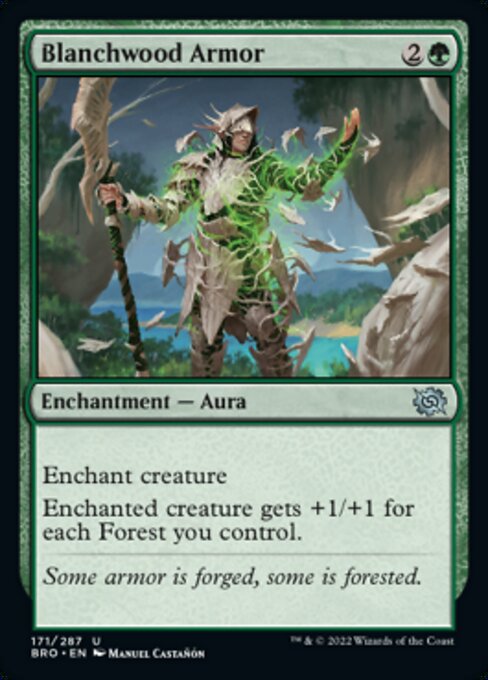
A well known reprint Blanchwood Armor is a high risk, high reward proposition. Be careful not to play this into open mana, for fear of a blow out, it also requires a target with some form of evasion to really shine. That said, the times you land this on a flying artifact or big Green creature with trample it may well win you the game.
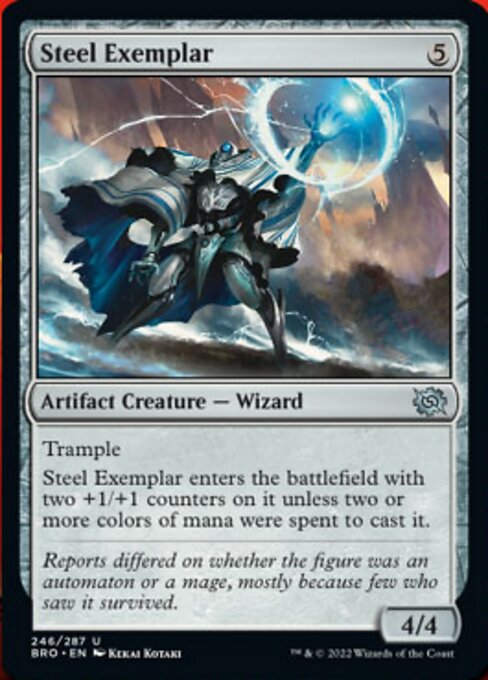
A notable colorless uncommon Steel Exemplar will obviously fit into any of the mono color decks. Although a 6/6 with trample isn’t a mind blowing statline for five mana it still represents a solid payoff for going mono.
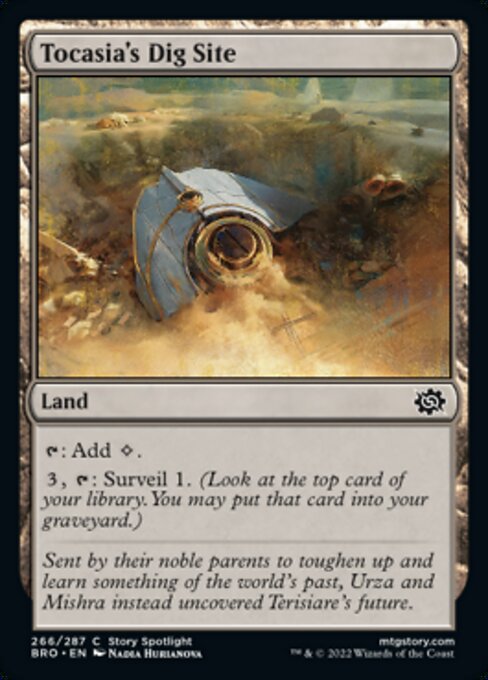
Finally, it's worth mentioning the common utility land in the set Tocasia's Dig Site. Due to the lack of fixing in this set, two color decks will rarely be able to run colorless lands and so this card should frequently wheel. Not exactly a powerhouse it will still improve your deck by protecting you further against flood.
The Brothers' War

Two Color Archetypes
Azorius (White-Blue)
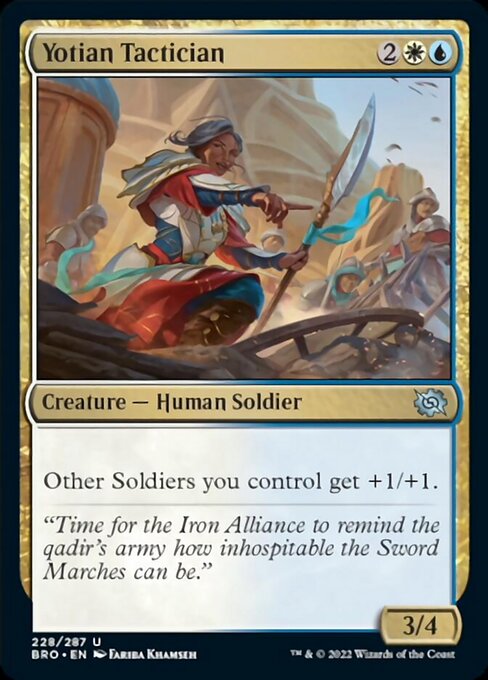
The theme for Azorius isn’t overly complicated this time around, it’s soldiers, lots of em. Yotian Tactician, the signpost uncommon, makes that pretty clear. With just one other soldier on the battlefield this card represents 4 power and 5 toughness for four mana and of course the sky's the limit in that regard. Clearly this color pair will be rewarded if it can flood the board with this creature type.


Luckily for us, there’s no shortage of soldiers to choose from in this color pair. Front runner for the most gluey card in the set, Mass Production puts a whopping four soldiers onto the board in one fell swoop. Whereas Zephyr Sentinel, an excellent rate card in its own right, also offers a rescue package for any creatures in a difficult spot.
Selesnya (White-Green)

This color pair, as shown clearly by Yotian Dissident, cares about artifacts entering the battlefield. With enough artifacts entering play the Dissident has the potential to become a credible threat itself or better still spread the risk by buffing another creature. Thopter Architect, another payoff for the theme grants flying and will be a premium pick up for those with enough enablers.
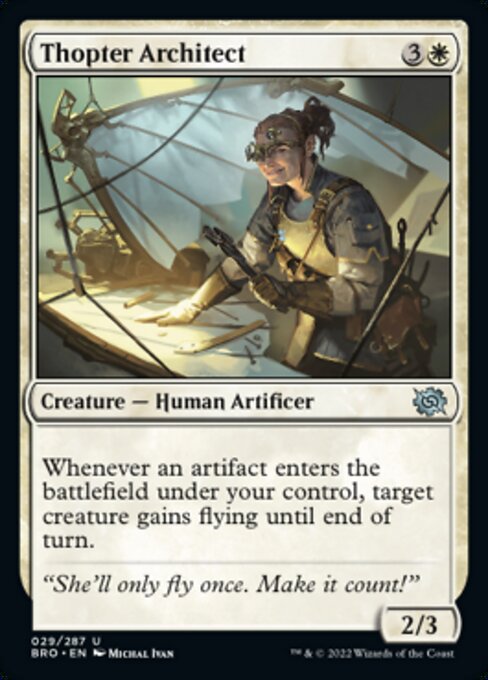
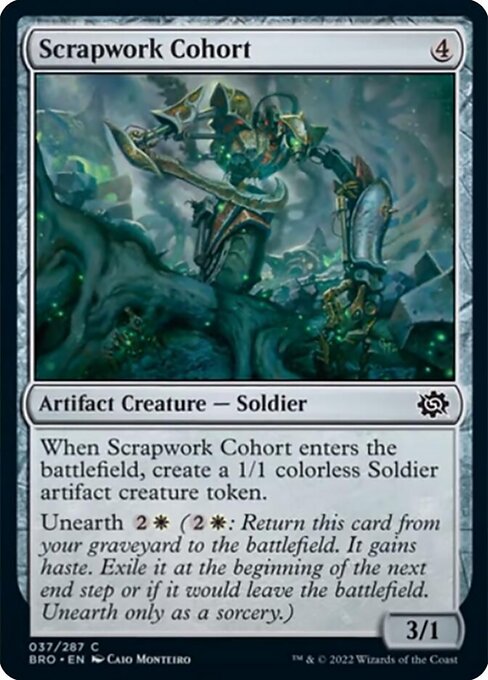
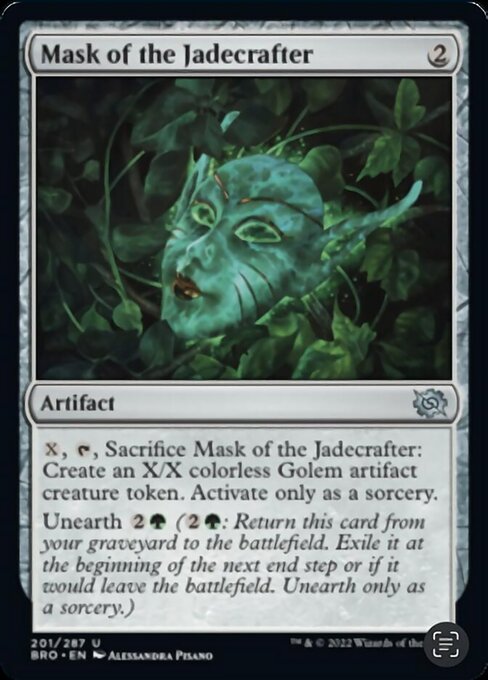
Both Scrapwork Cohort and Mask of the Jadecrafter are likely to find a home in this archetype, each providing multiple artifacts from a single card. Neither of these cards represent excellent value in a vacuum, but with up to four triggers a piece they certainly have synergistic potential.
Dimir (Blue-Black)
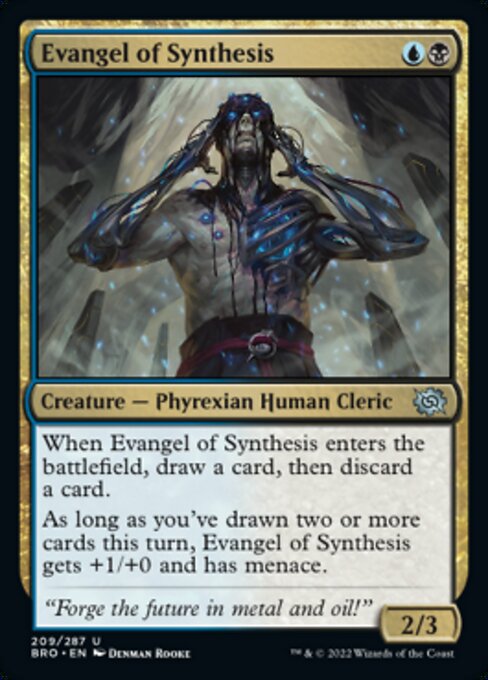
Dimir’s signpost uncommon Evangel of Synthesis is a nicely costed 2/3 body which allows you to loot when it enters the battlefield. It’s the static ability here however that indicates Dimir’s strategic direction. By drawing cards, something we would love to do anyway, we can turn this two drop into a credible threat.
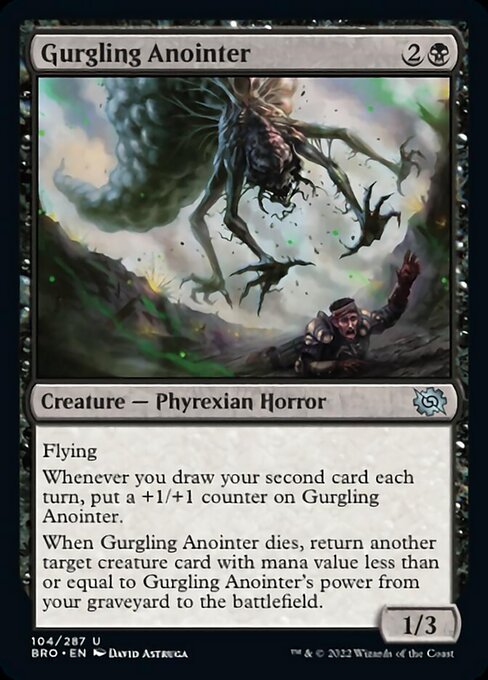

Creatures such as Gurgling Anointer and Thopter Mechanic reinforce the theme, both benefiting when we draw cards which is trivially easy to do in both Blue and Black. They also both have sweet triggers when they die meaning that dead or alive they will continue to affect the battlefield.
Of course the key to success in this type of archetype is balancing your payoffs against your enablers. Here that means having plenty of ways to draw cards. Luckily for us Blue is packed with looters and draw spells and even black has multiple ways to draw cards.
Rakdos (Black-Red)
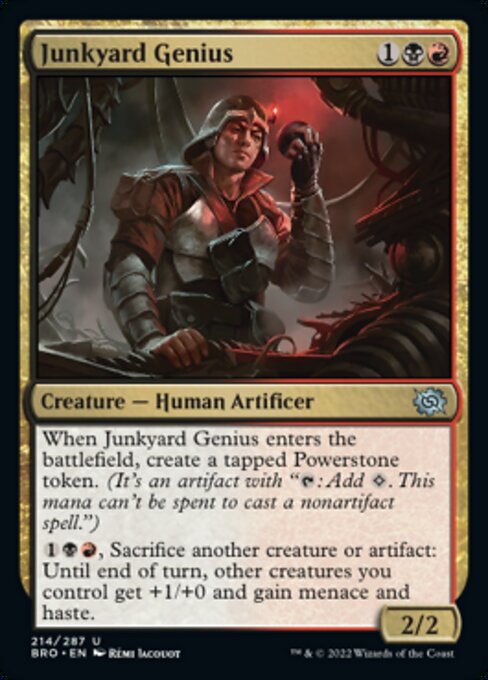
Rakdos’ signpost uncommon Junkyard Genius, is pointing us towards a familiar theme in this color pair; sacrifice! Of course this time around we are able to sacrifice artifacts as well as creatures which is only fitting for an artifact set.
This card is strong partly because it’s synergistically self-contained. The Powerstone token provides initial ramp, allowing you to get your team onboard quickly, but can also be sacrificed later to gain the trigger. Let’s face it, pumping your entire team whilst simultaneously giving them menace and haste is no joke and will put some serious pressure on your opponent.
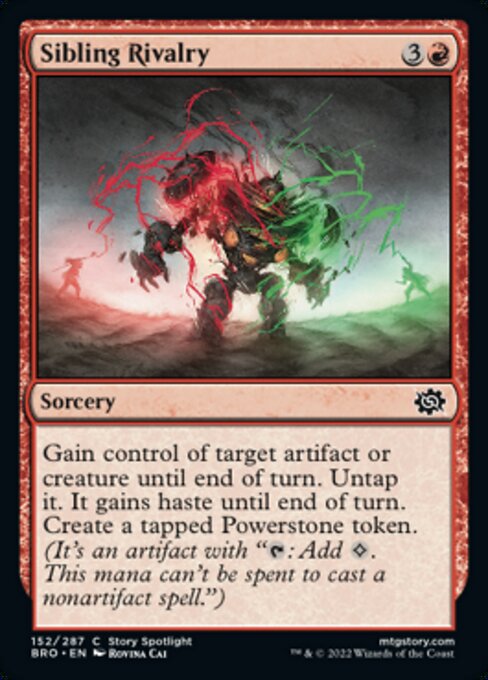
For those with a little mana to spend Sibling Rivalry will make an excellent addition to the archetype. Of course steal and sac is nothing new in limited but it sure is a great way to destabilize your opponents board and swing a game in your favor. Getting the Powerstone here is nice, as it can provide a little extra mana to activate a sacrifice trigger.
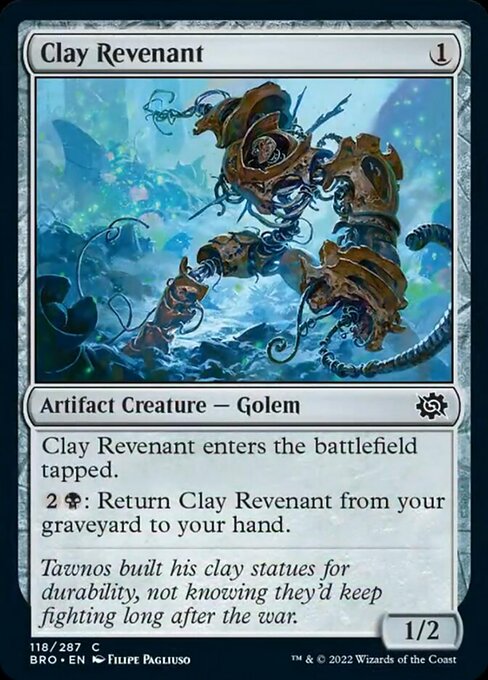
Perfect for those looking to grind their opponents out Clay Revenant is ideal sacrifice fodder. Cheap to get on the board this can be raised from the dead over and over again meaning you can gain trigger after trigger after trigger.
Gruul (Red-Green)

Unlike the other color pairs, Gruul’s signpost uncommon doesn't seem to be pointing us in any specific direction. Clearly Arbalest Engineers is a strong and flexible card; 3 power and 3 toughness for three mana is a solid baseline and the other abilities may come in handy in certain situations. Yet it doesn’t provide a clear path to help us navigate the draft.


Without any solid theme, a return to basics is probably a solid approach with Gruul. Powerful removal spells such as Obliterating Bolt may pull you into red whereas a card like Obstinate Baloth might tempt you into Green. That said, with fewer reasons to enter this archetype it’s likely best left alone unless both colors are wide open.
The Brothers' War

Orzhov (White-Black)

Orzhov’s theme is reanimation, or more specifically reanimating creatures with mana value three or less. The signpost here, Hero of the Dunes, may be a little on the small side, however, returning an artifact or creature from the graveyard to the battlefield is a serious bonus. It’s the ability to pump your team, however that pushes this card over the edge. Assuming we can pack out the board with one, two and three drops, this has the potential to be game changing.
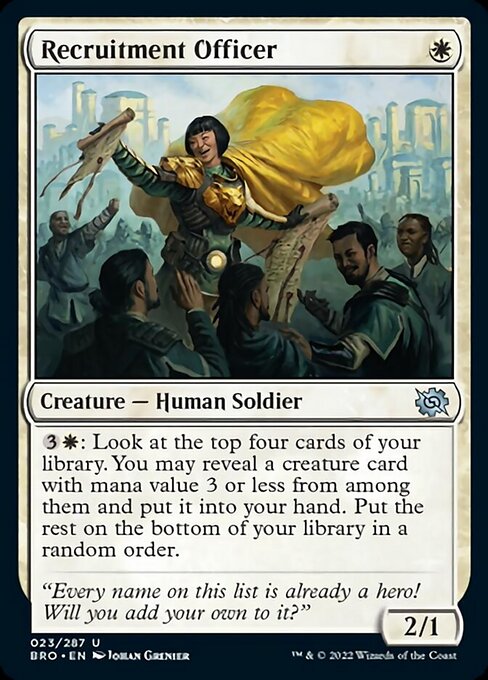
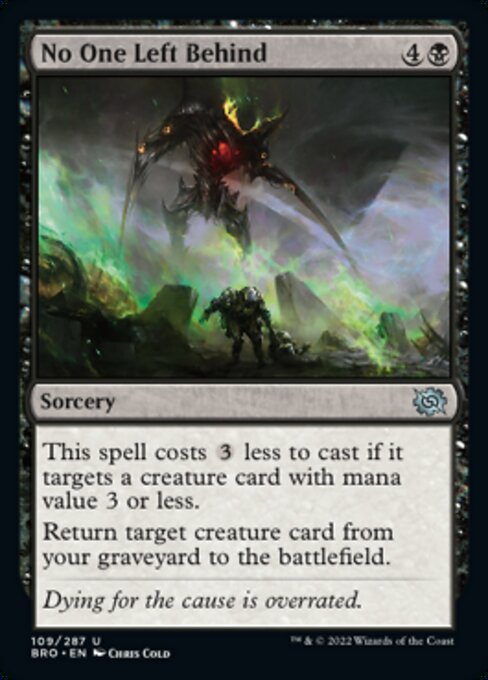
Other payoffs for the archetype include Recruitment Officer which offers an excellent reanimation target for a player with mana to spend and bodies available in their yard. Whereas No One Left Behind is an interesting take on the usual five mana reanimation spell. Getting a cost reduction for cheap creatures makes this more flexible and, assuming we have high value targets, gives it more potential too.
Golgari (Black-Green)
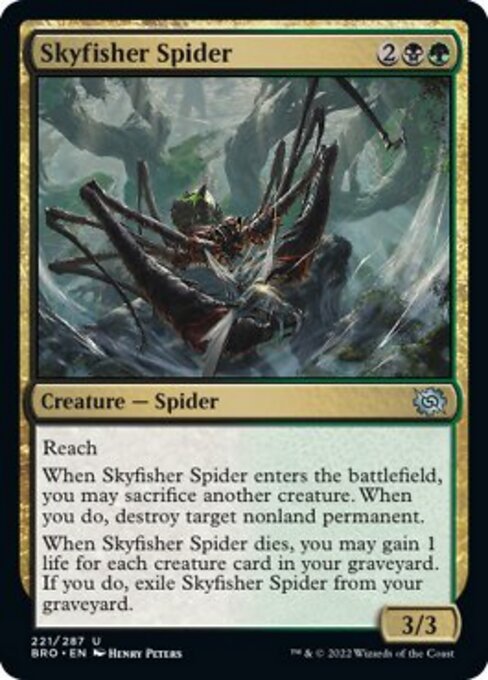
Golgari’s signpost uncommon, Skyfisher Spider is a powerful card make no mistake. Exchanging your worst creature for your opponent's best permanent will often feel like a two for one and the life bump when it dies is a nice addition.
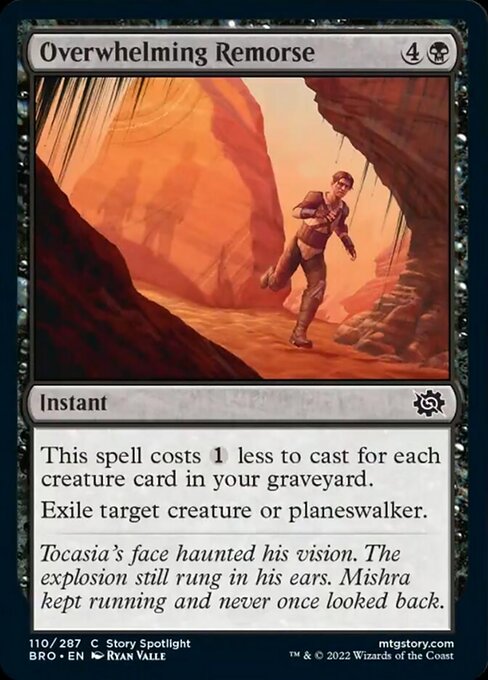
This time around Golgari’s theme is the graveyard; or more specifically having a large number of creatures in your yard. Overwhelming Remorse is a fine payoff for this archetype, although one that many players will have their eye on. Five mana to exile a creature or planeswalker at instant speed is only a little below rate and it won’t take much work to make this an incredibly efficient removal spell.
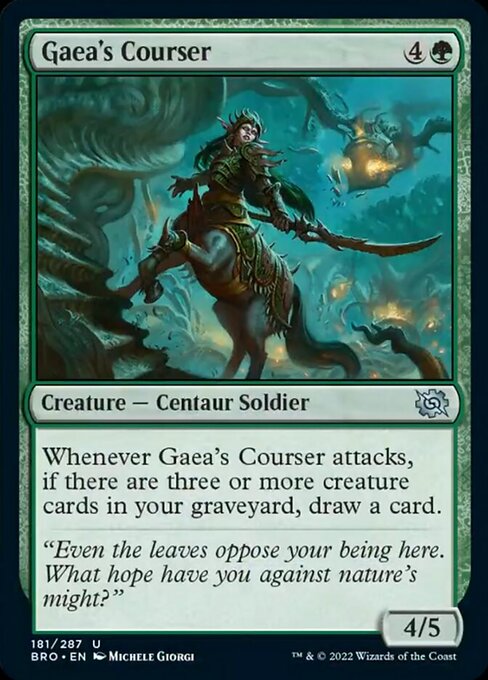
Gaea's Courser is another payoff here, although one that requires considerably more work. Three creatures in the yard isn’t unreasonable, however untapping with this thing and having good attacks may be a stretch in some games. Of course, when things go well, this is exactly the sort of card that can run away with a game.
Izzet (Blue-Red)
As per usual, Izzet’s theme revolves around casting non-creature spells. Of course this includes artifacts, so for once we won’t need to load up solely on instants and sorceries. Third Path Iconoclast makes a great early game play, assuming we can follow it up with a barrage of suitable spells. As does Monastery Swiftspear, a long awaited addition to MTG Arena.
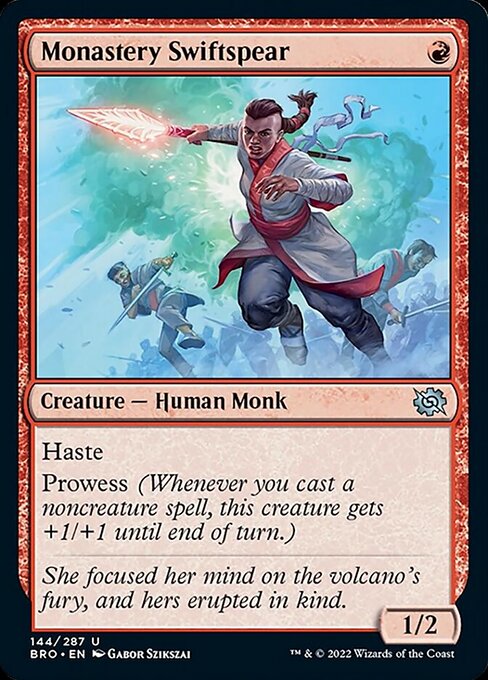
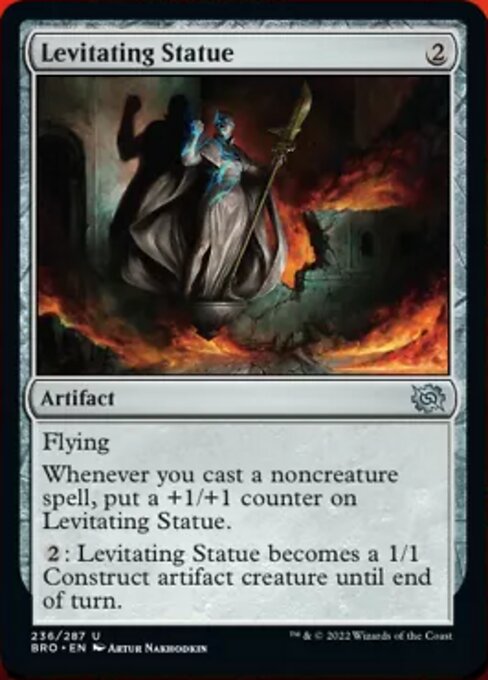
Searching for non-creature spells we find Levitating Statue, which has the potential to be great in this archetype. Providing a threat that grows over time, this has the added benefit of allowing you to affect the board whilst still counting as a noncreature spell.
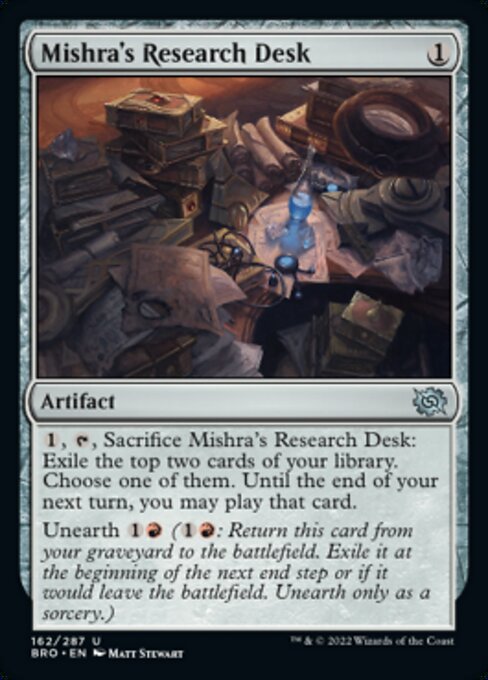
Mishra's Research Desk provides a way to keep the cards flowing whilst also giving a couple of non-creature triggers. Efficient this is not, however the modular nature of this card and the selection it provides may be enough to make up for that in the right deck.
Boros (White-Red)

The signpost here, Fallaji Vanguard, leaves no doubt that we should be turning creatures sideways, as per usual, in Boros. With a single creature entering the battlefield during your turn, this could be attacking as a fearsome 4/3 first strike, a statline that is extremely difficult to deal with in combat.
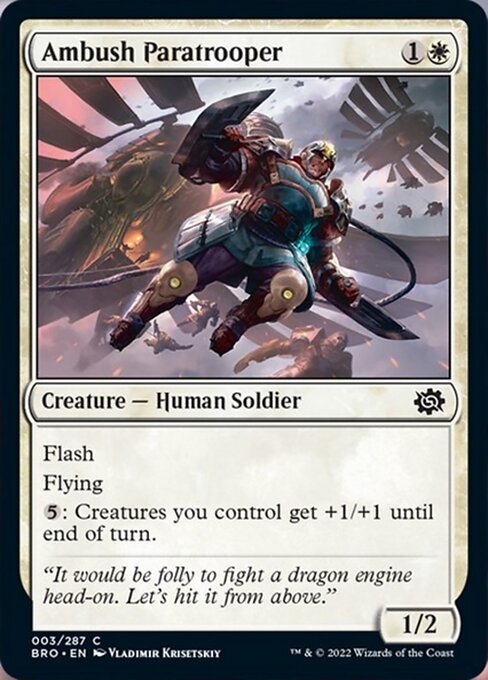
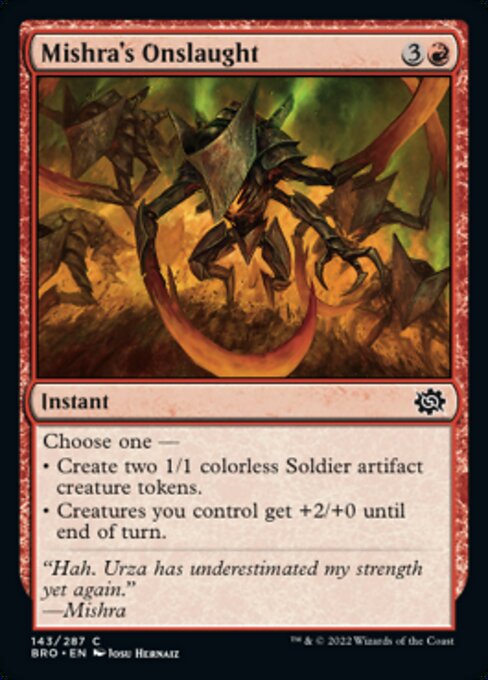
It’s the ability to ‘throw’ this bonus around, however, that really makes the Vanguard formidable. With this card on the board, creatures with flash such as Ambush Paratrooper can become combat tricks in their own right. Whereas an instant like Mishra's Onslaught has the potential to be devastating when timed right, using either mode.
Simic (Blue-Green)
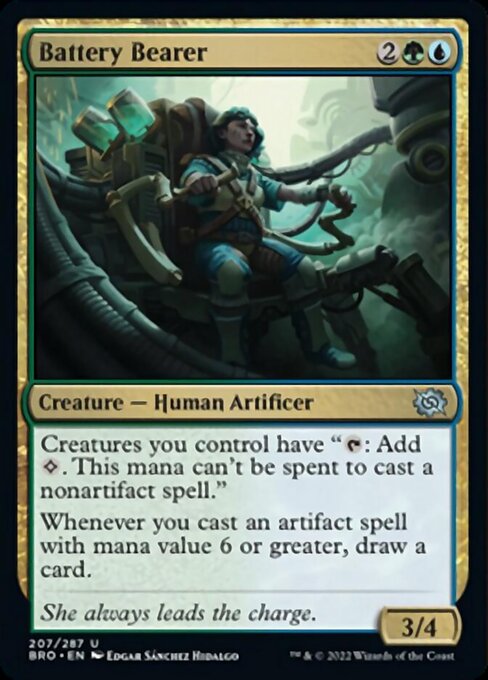
Simic’s signpost uncommon Battery Bearer is another card that is both an enabler and a payoff for a specific strategy. Providing the means and the end, this card turns all your creatures into mana dorks before paying you off for casting huge artifacts. Perhaps I’m just a sucker for Simic Ramp but this seems like a pretty sweet plan to me.
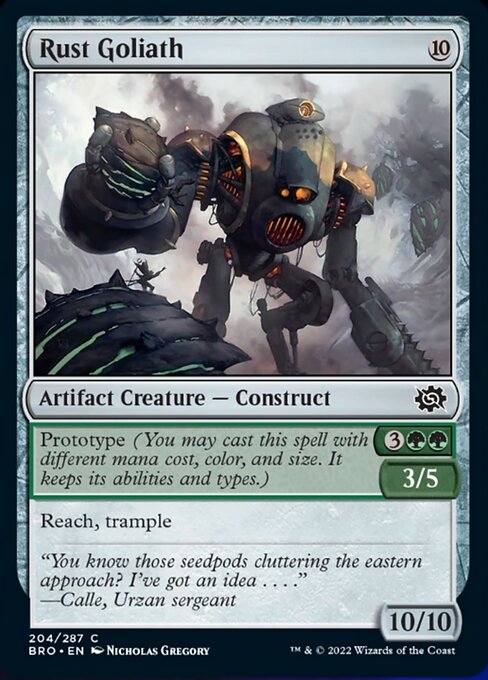
Partly thanks to the Prototype mechanic, The Brothers’ War has no shortage of huge artifacts to ramp into. Rust Goliath for instance has the potential to be an earth shattering 10/10 with reach and trample but also has the fallback option of being cast as a Spider variant. This get out clause is worth its weight in gold, as many players know, being stuck with an uncastable ten mana card is a great way to lose a game.

Argivian Avenger also looks like a great fit for this type of strategy. Not too expensive, it’s extremely versatile and just costs enough mana to net you a card with the Battery Bearer.

In terms of backup enablers Fallaji Excavation looks a little thin to be worth a card. However, in a deck packed with high mana cost monstrosities, the tempo loss might be an acceptable trade off, if it allows you to cast them on curve.
The Brothers' War

Top Commons
White
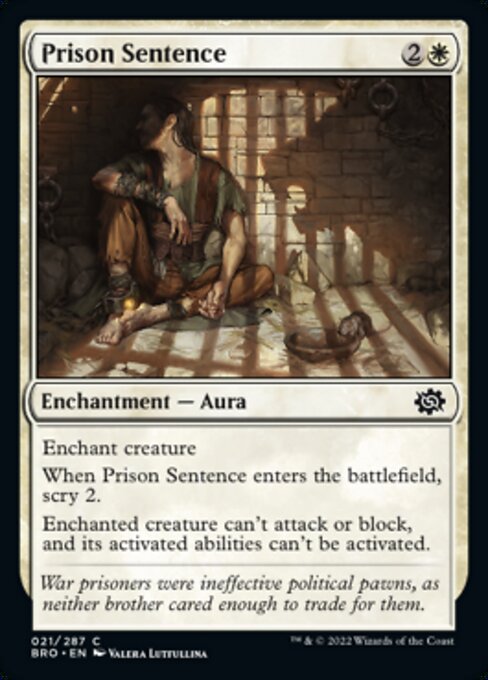
The value of enchantment based removal fluctuates from set to set. With a sacrifice theme in Rakdos and the presence of a main deckable Disenchant at common, a card like Prison Sentence may be a little more fragile than usual. That said, the Scry 2 attached to this card goes a long way to negate these downsides as does the fact that this also prevents activated abilities. For aggressive decks in particular, the ability to remove a blocker whilst simultaneously digging for more action makes this a premium pick up.
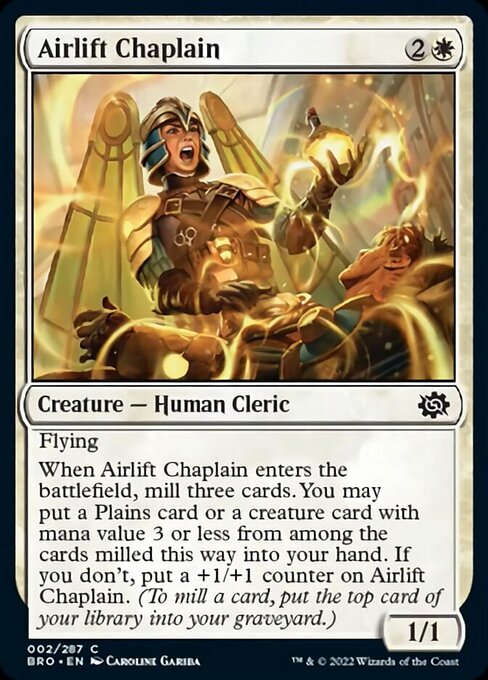
In recent memory, White has frequently been gifted with a common three mana creature that draws a card when it enters the battlefield. Although not nearly as powerful as say Inspiring Overseer from SNC, Airlift Chaplain is the latest incarnation in this vein. A three mana 2/2 flier at its base level, the value of the Chaplain will clearly vary depending on the other cards in your deck. Of course, hitting a Plains or a creature card will be the sweetest, however don’t sleep on the value of the mill alone. The presence of the Unearth mechanic and a reanimator theme both make getting cards in your yard a value proposition.
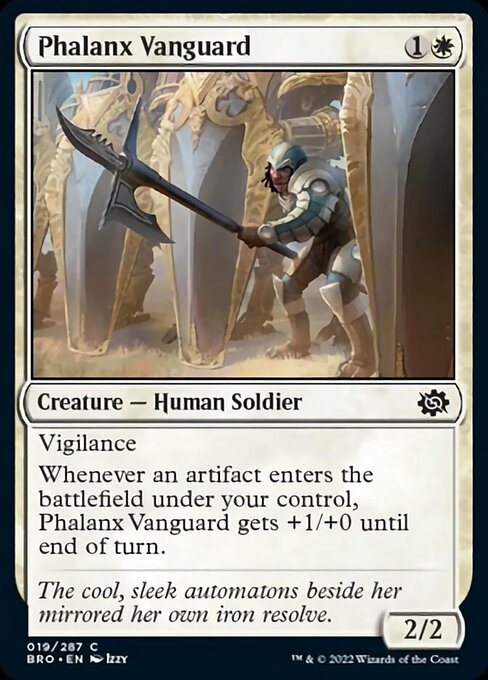
White’s four color pairs; Azorius, Selesnya, Orzov and Boros each naturally have their own plan of attack. Azorius is looking for Soldiers and Selesnya for Artifacts whereas Orzhov requires creatures of mana value 3 or less, as does Boros frankly, being super keen to turn creatures sideways. Phalanx Vanguard, a low cost soldier that benefits when artifacts hit the battlefield, lies at the intersection of all four of these strategies. As such, this card makes the top commons list due to its flexibility and cohesiveness rather than because of an insane level of power.
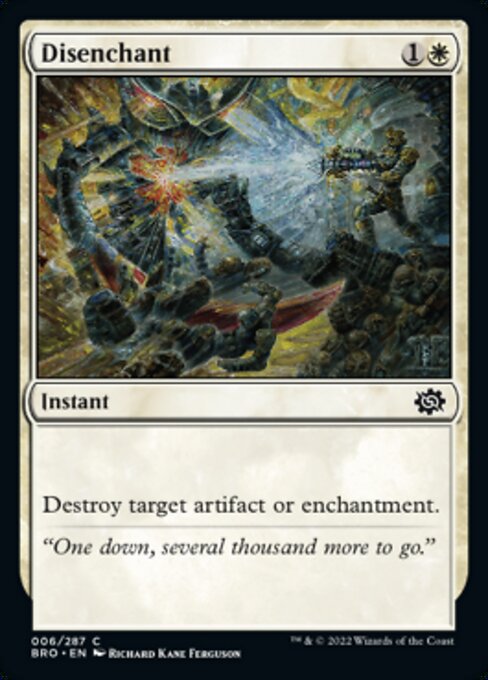
White’s one to watch is worth a mention since, due to the high number of artifacts running around, Disenchant will be main deckable for the first time in a while. Exactly how many copies of this can be played remains to be seen but including one main deck certainly won’t be a mistake.
Blue

With around two thirds of cards in the set being either a creature or an artifact, Scatter Ray will frequently find a target. Although a four mana tax won’t stop your opponent forever, especially with Powerstones hanging around, it will certainly hold its value for the early and middle rounds of the game. The presence of several other instants in Blue also help elevate Scatter Ray, ensuring you won’t burn your mana when a target doesn’t present itself.
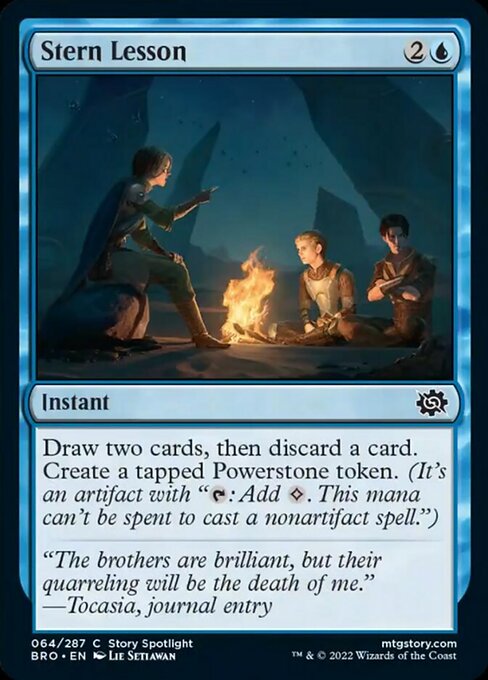
Although Stern Lesson doesn’t strictly provide card advantage, it will certainly allow you to dig through your deck. Those playing the draw two strategy in Dimir may want several copies of this, as will those playing Izzet’s spells matter theme. Naturally ramp strategies, such as that seen in Simic will be happy using this to accelerate their mana whilst searching for their finishers. Without those synergies, however, this card will be a little underwhelming, unless of course you can use the discard to place an Unearth creature in your yard.
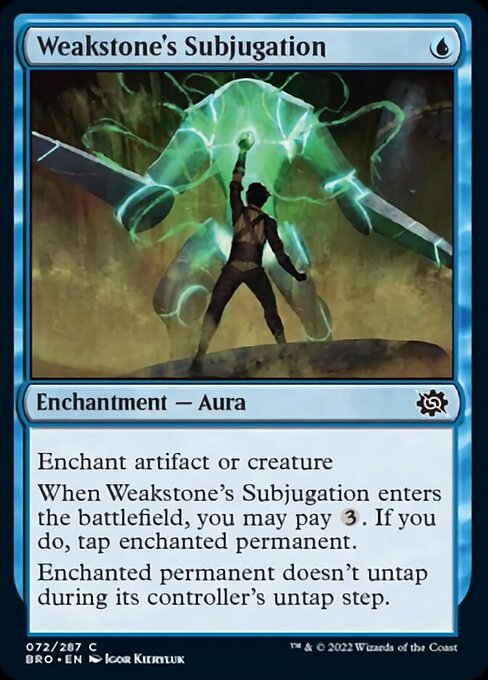
Able to hit both creatures and artifacts, Weakstone's Subjugation is versatile and, on the occasions you cast it for one mana, extremely efficient. Of course the four mana version is a lot less exciting, however it can obviously affect a much wider range of targets. With Disenchant running around, this type of effect certainly comes into question but the upside of casting this for one mana goes a long way to appease that.
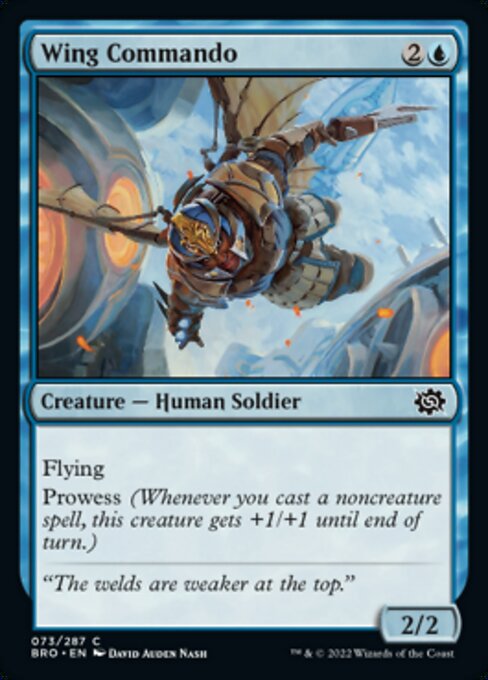
Blue’s one to watch is Wing Commando. This flying soldier has potential to be strong in Azorius however it’s Izzet who will be most excited to pick this up. Assuming Red Blue spells is a force to be reckoned with, and it certainly looks that way from the spoiler, Wing Commando may be responsible for pushing an awful lot of damage in the air.
Black

Black’s premium common removal spell Overwhelming Remorse is, as usual, no slouch. Not only does this exile its target but it can also target planeswalkers for what that’s worth. Of course, it's the mana cost discount here though that makes this truly excellent. Those playing Black decks should have no trouble getting creatures into their graveyards - at which point this card can become incredibly efficient.
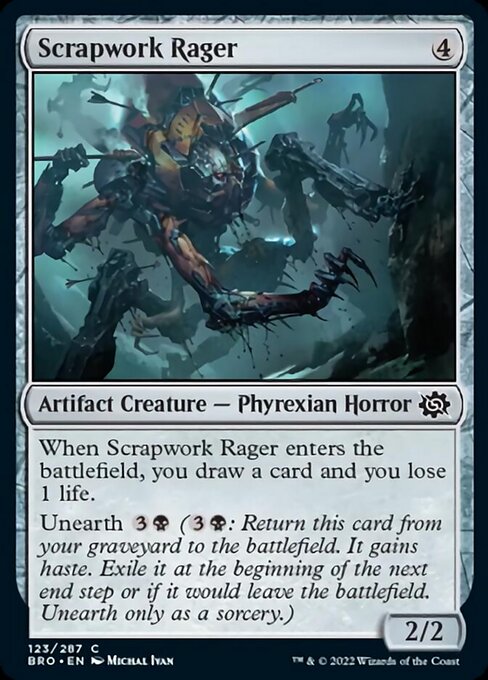
Phyrexian Rager’s little brother Scrapwork Rager may cost one more mana to cast, however it’s Unearth ability more than makes up for that. Pretty much any creature that draws you a card on ETB is worth putting in your deck these days and this is no exception. Hard casting this is of course fine, however there are multiple ways to get artifacts into your yard so there’s plenty of opportunity for value adding shenanigans.
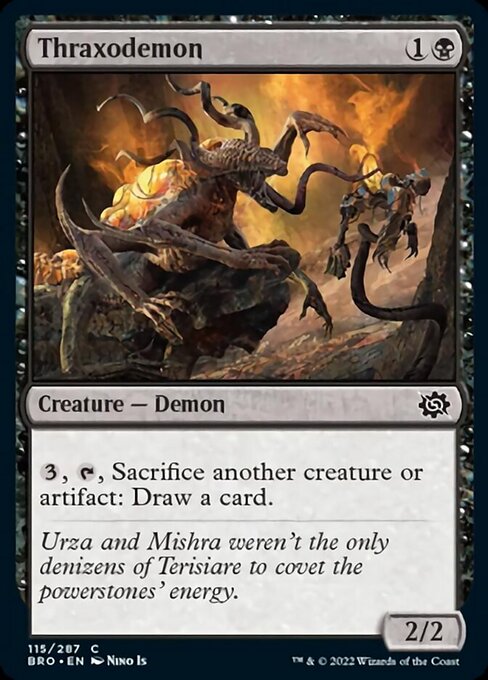
Thraxodemon is a gluey card which appears as though it will excel in any of Black’s archetypes. Enabling Dimir’s draw two theme and providing a sacrifice outlet for Rakdos may be its main strengths. However it’s not difficult to see how this card can also help fill the graveyard, enabling both Ozhov’s reanimator and Golgari’s graveyard matters themes.

Not exactly archetype specific, Black’s one to watch is Emergency Weld. Getting back your best artifact or creature card from the yard whilst simultaneously affecting the board seems like a pretty sweet deal. However, this card will only really shine in decks looking to play a longer game. Those with an aggressive plan in mind should probably steer clear, unless of course you have multiple bombs to buy back.
The Brothers' War

Red

Red’s premium common removal spell Excavation Explosion looks a little less exciting this time around. I mean dealing three damage for three mana isn’t exactly efficient and sorcery speed really limits the options here. However, the simple fact that this can go face and burn your opponent pushes it up through the ranks, as does the tapped powerstone that it creates.
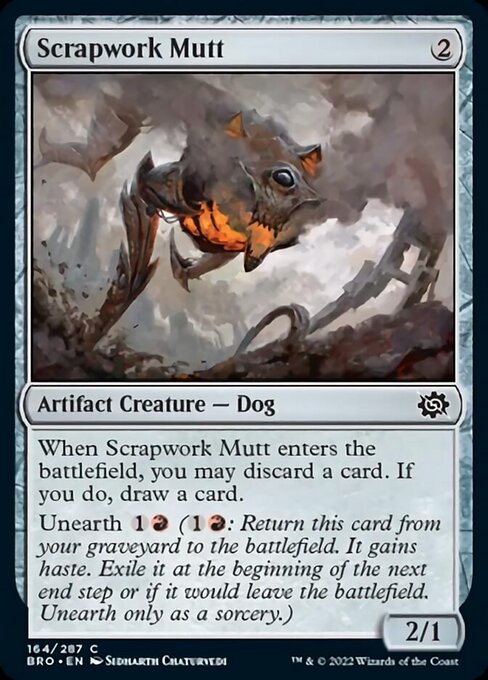
Likely to be Red’s best common two drop, outside of dedicated spells matter decks that is, Scrapwork Mutt gives you some much needed card selection attached to a reasonable body. Able to draw you into an early land or protect you against flood, this card is excellent in multiples since getting this into your yard provides future value thanks to Unearth.
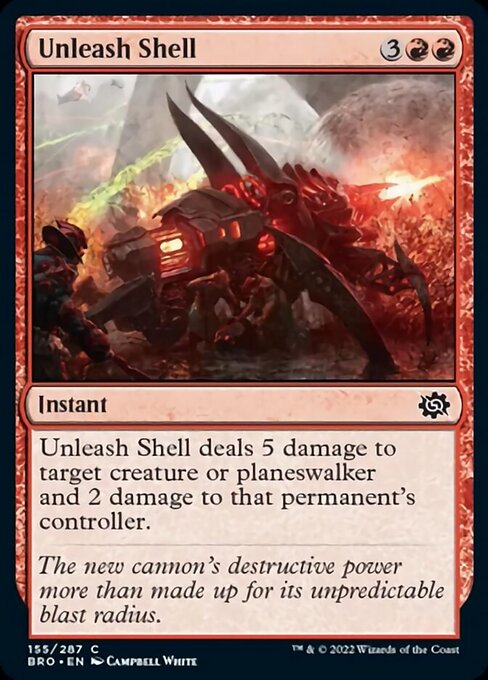
With most of Red’s color pairs looking aggressive, Unleash Shell is likely to be a little better than it looks on face value. Five mana damage based removal often isn’t premium. However, we’ve seen this type of effect before and, for those looking to push damage, the extra two to your opponent can really make a difference. In addition to the fact that it will remove most blockers, this will help trigger the spells matter theme and the instant speed certainly adds value.
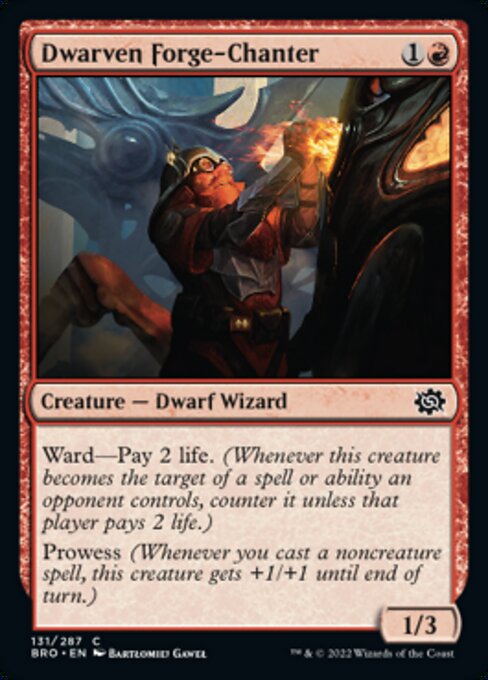
Red’s one to watch is Dwarven Forge-Chanter. Clearly designed for the Izzet spells matter theme, this card may also find a home in an aggressive mono red spells deck, assuming such a thing exists in the format. A card that’s excellent in multiples, blocking this dwarf is going to be tricky any time your opponent has open mana. In addition the life tax means that removing it is never pain free making stabilizing extremely difficult.
Green

Although 3/2 bodies for three mana usually don’t make the cut, Argothian Opportunist bucks that trend by bringing along a Powerstone. With Green having some of the bigger and scarier looking artifact creatures to ramp into, there will be ample opportunity to take advantage of this token in any of the color pairs.
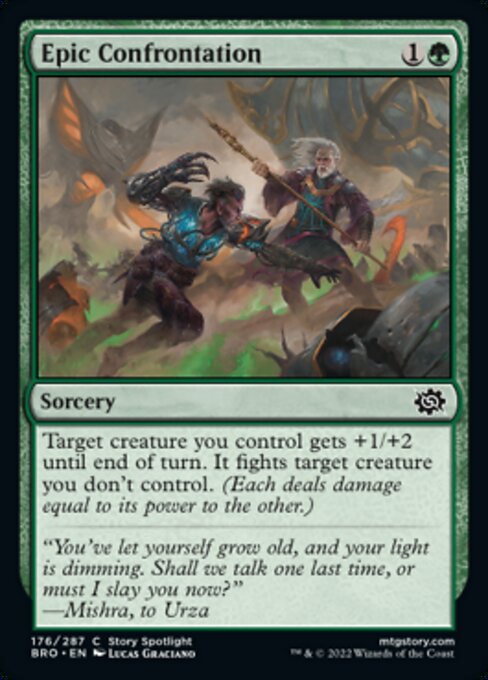
The fact that Green’s fight spell, Epic Confrontation boosts both power and toughness is a big deal. Of course we’d like this to be instant speed - which would make it more versatile and less prone to blow outs. However, by taking a little care, you should still be able to get maximum value from this card.

As mentioned Green has some seriously big artifact creatures in this set. Rust Goliath weighs in at a seriously scary ten power and ten toughness with both Trample and Reach to boot. Now generally speaking, ten mana spells are a liability and not something I'd recommend putting in your deck. However, the Prototype mechanic gives this card a safety valve - allowing you to cast it as a spider variant when you need to. Essentially this makes Old Rusty a free finisher for any Green deck with enough Powerstones.
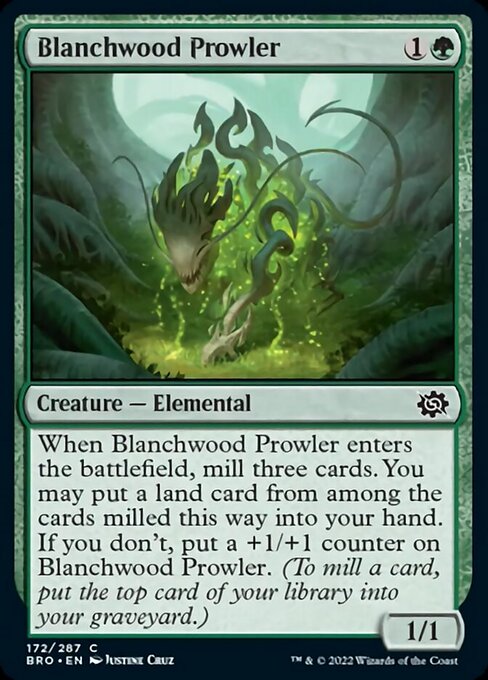
Green’s one to watch is Blanchwood Prowler. This card will clearly be a strong enabler for the graveyard matters theme in Golgari. A 2/2 for two that mills three cards is more than good enough for that archetype and the fact that it can bag you a land may make Golgari the most likely archetype to splash.
Colorless

With no common dual lands in this set and fixing thin on the ground, I'll be valuing Evolving Wilds quite a bit higher than usual. Picking a land might not seem like a high priority for newer players, however without dual lands to improve our manabases, screw and flood are likely to occur on a more frequent basis. As such investing in your mana becomes a wise move even when you don’t intend on splashing.
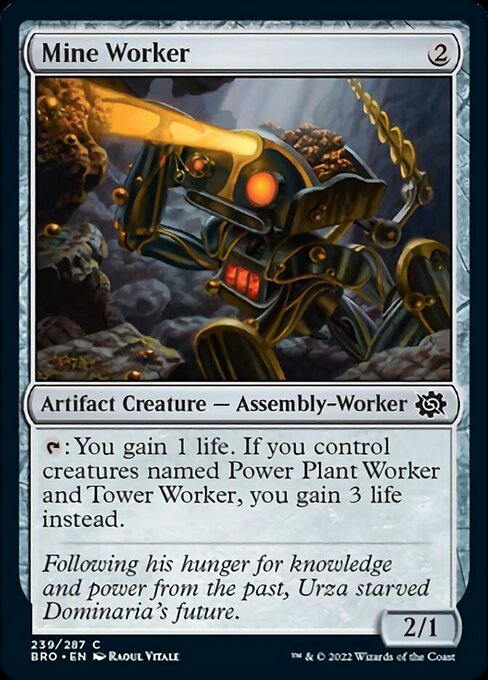
A two mana 2/1 that taps for a life bump Mine Worker, deserves a mention simply because it’s an acceptable two drop that any player can jam into their deck. Whether you want to go ham and rally the assembly workers' answer to Tron is up to you but I'll be looking out for this card whenever I'm hurting for two drops.
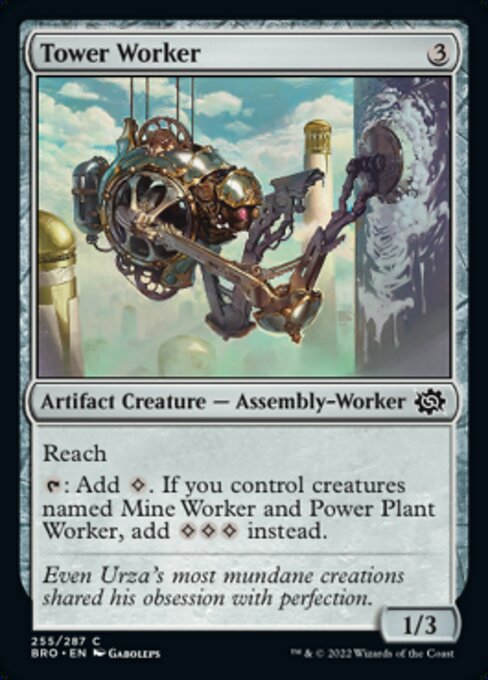
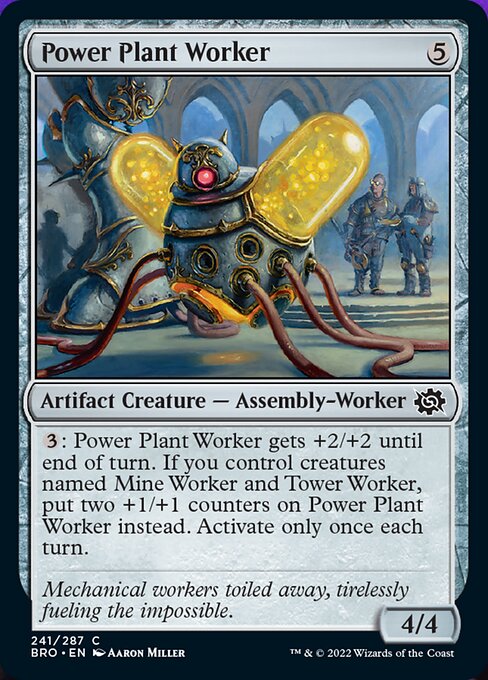
A four mana 2/3 is a card that needs help to be good and Stone Retrieval Unit doesn’t quite get there. It is worth mentioning however, as a colorless common which creates Powerstones. For those building ramp or artifact decks, this will be a reasonable fall back for the times when better options haven't presented themselves.
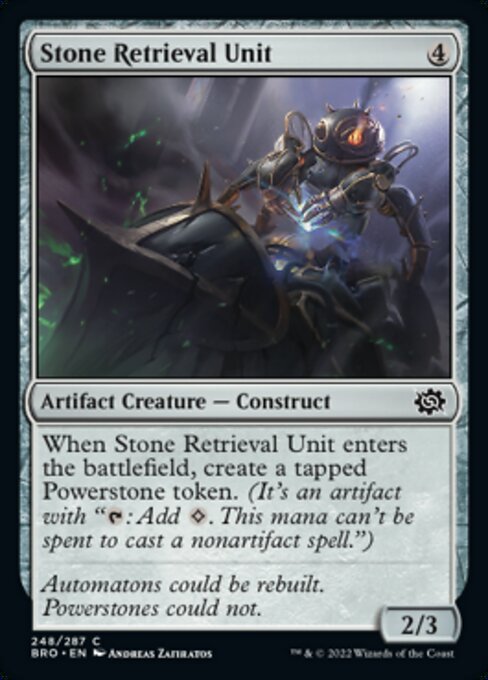
Final Words
Thanks for making it all the way through with me. As I’m sure you can tell, I'm super excited about this new set! If you’re looking to draft with your friends then please consider buying a draft box from Amazon using my affiliate link. This will help to keep the site alive and allow me to keep writing great content. Many thanks and good luck in your first few drafts! Dave ‘Angri’ Warner.
Affiliate link - More info.
Check Price
Dave ‘Angri’ Warner
Angri started playing Magic The Gathering during the Ice Age expansion. Proud to have collected a full set of 4th Edition, he was horrified to discover that, whilst he was away at college, his mom had donated his cards to a thrift store! With two mathematics degrees safely under his belt, Angri turned his attention to the world of online poker. Following a 10 year stint as a professional poker player, he finally returned to the glorious game of his youth. When not found playing or writing about MTG, he enjoys hanging out with his small family or riding an electric bike around the polluted English city he calls home.
Affiliate Links
This page contains affiliate links. As an Amazon Associate I earn from qualifying purchases. This means that, If you choose to purchase a product after following this link, I will receive a small commission. Many thanks to anyone choosing to do this - it will allow me to keep publishing great content, Dave.
The Brothers' War

The Brothers' War

The Brothers' War

The Brothers' War

The Brothers' War

The Brothers' War

The Brothers' War
